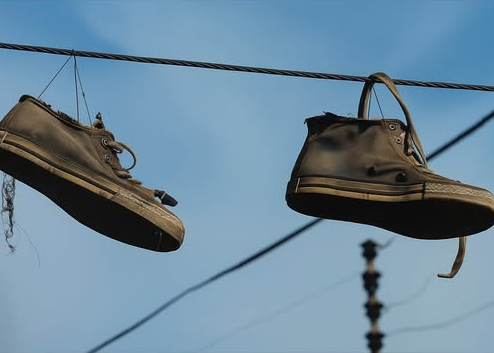You’ve probably seen it—a pair of sneakers tied together by their laces, hanging from a power line, swaying high above the street. It’s one of those quirky urban sights that most people don’t give much thought to. But for decades, these dangling shoes have sparked curiosity, speculation, and even rumors about their meaning.
The truth? It’s not as simple as it might seem. The tradition, or perhaps habit, of tossing shoes over power lines has appeared in cities and small towns across the globe, and depending on where you are, it can carry different meanings—sentimental, rebellious, or symbolic.
Let’s dig deeper into this unusual yet iconic sight.
From the Military to Main Street
One explanation traces this practice back to military roots. Some say that soldiers, after completing their training or a tour of duty, would tie their boots together and toss them over power lines as a personal ritual—marking the end of a difficult chapter and symbolizing survival. It wasn’t meant for the public eye but was a small, private way to say, “I made it through.” Over time, this custom spread from veterans to civilian communities, becoming a symbol of resilience and transition.
In this context, the shoes hanging above weren’t a statement, but rather a quiet homage to overcoming adversity.
The Gang Territory Myth
Another theory, fueled by urban legends and crime dramas, suggests that shoes thrown over power lines signal gang territory or locations for drug dealing. Some versions say the shoes are used to mark a fallen member or a place where illicit activities take place.
However, law enforcement in many cities, including Los Angeles and Chicago, has debunked this myth. They’ve stated there’s little to no connection between power-line shoes and criminal activity. Still, the idea persists in pop culture, as people are often quick to attribute a mysterious image to something sinister.
The Playground Prank
You’ve likely seen this version too—a harmless, if mischievous, prank. In countless coming-of-age stories, the classic bullying act involves stealing a kid’s shoes, tying them together, and tossing them onto a wire or roof. It’s a way to humiliate someone and mark a moment of domination. For those who remember playground antics, these shoes can bring back memories of teasing and childhood cruelty.
But in this case, the shoes are not symbols of power—they represent embarrassment, singled-out moments of vulnerability. For many, these images evoke mixed feelings of nostalgia and unease.
Harmless Pranks and Late-Night Dares
For others, these hanging shoes are simply part of youthful mischief—a spontaneous act with no hidden agenda. Teens and young adults often toss shoes over power lines to mark a celebration, a victory, or just as part of a dare. It’s something done in moments of joy, frustration, or even boredom. The shoes are just a fleeting symbol of whatever was happening at the time—sometimes nothing more than a shared joke among friends.
Street Art and Urban Identity
In more recent years, the image of shoes hanging from power lines has been adopted by artists and photographers as a form of street-level expression. It’s now considered a visual symbol of urban identity—something gritty, nostalgic, and even poetic. In some places, the act has transformed into an art form, with installations intentionally placed to make a statement about memory and belonging.
For residents in these areas, those dangling shoes represent who has passed through their neighborhood—who lived, who left, and who was once a part of the community. The shoes serve as reminders of the lives, the struggles, and the stories tied to that space.
Memorials in Disguise
In some cases, the shoes carry a deeper, more emotional significance. For grieving friends or family members, throwing a pair of shoes on a power line serves as an informal memorial for someone who’s passed—particularly for young people taken too soon. The shoes are placed in a place where the deceased person once spent time, often in quiet remembrance, without labels or formal markers.
These shoes may look like random vandalism to outsiders, but to those who understand, they’re a personal tribute—a reminder of love and loss.
The Common Thread
Regardless of the theory, one consistent element remains: the act of throwing shoes over a wire is a way of leaving something behind. Whether it’s a rite of passage, a memorial, or an act of rebellion, the shoes symbolize transition, movement, and memory.
Shoes, by their nature, are personal. They carry traces of where someone has been. Hanging them in a public space makes them visible but untouchable—caught between the earth and the sky, between presence and absence. And that’s what gives the image its power, even if the meaning changes from one street to another.
The Practical Side
Of course, utility companies don’t always share the same romantic view of hanging shoes. Shoes can damage power lines, interfere with maintenance, or cause hazards if they fall near transformers. Many cities remove shoes as part of regular maintenance, especially in areas where they could pose a risk to the public or disrupt electrical work.
So, while the practice remains a part of urban culture, it’s becoming less common as digital footprints take over.
What Those Shoes Still Say
Ultimately, the meaning behind shoes hanging from a power line depends on who’s looking and where they are. To some, the shoes might symbolize rebellion or defiance. To others, they’re a tribute or a mark of remembrance. To most, they’re just another part of the urban landscape—a reminder that life continues to unfold all around us, even in the most unexpected places.
Next time you see a pair of shoes swaying above the street, don’t just ignore them. Pause. Take a second look. Maybe they tell a story of someone celebrating, grieving, or simply trying to reach for something just out of their grasp.
